Study of the Resistance of Lithium-Containing Ceramics to Helium Swelling
Abstract
1. Introduction
2. Materials and Methods
2.1. Characterization of Initial Ceramic Samples
2.2. Simulation of Helium Swelling
3. Results and Discussion
4. Conclusions
Author Contributions
Funding
Institutional Review Board Statement
Informed Consent Statement
Data Availability Statement
Conflicts of Interest
References
- Duerrschnabel, M.; Gaisina, E.; Gaisin, R.; Walter, M.; Aktaa, J.; Rieth, M. Nanoscale insights into the corrosion of EUROFER by lithium ceramics. Corros. Sci. 2022, 199, 110190. [Google Scholar] [CrossRef]
- Jiang, W.; Kovarik, L.; Wirth, M.G.; Zhu, Z.; Canfield, N.L.; Seymour, L.M.; Senor, D.J. Ion irradiation study of lithium silicates for fusion blanket applications. J. Nucl. Mater. 2023, 576, 154281. [Google Scholar] [CrossRef]
- Zandi, N.; Sadeghi, H.; Habibi, M.; Jalali, I.; Zare, M. Blanket simulation and tritium breeding ratio calculation for ITER reactor. J. Fusion Energy 2015, 34, 1365–1368. [Google Scholar] [CrossRef]
- Abou-Sena, A.; Ying, A.; Abdou, M. Effective thermal conductivity of lithium ceramic pebble beds for fusion blankets: A review. Fusion Sci. Technol. 2005, 47, 1094–1100. [Google Scholar] [CrossRef]
- Ihli, T.; Basu, T.K.; Giancarli, L.M.; Konishi, S.; Malang, S.; Najmabadi, F.; Wu, Y. Review of blanket designs for advanced fusion reactors. Fusion Eng. Des. 2008, 83, 912–919. [Google Scholar] [CrossRef]
- Leys, J.M.; Zarins, A.; Cipa, J.; Baumane, L.; Kizane, G.; Knitter, R. Radiation-induced effects in neutron-and electron-irradiated lithium silicate ceramic breeder pebbles. J. Nucl. Mater. 2020, 540, 152347. [Google Scholar] [CrossRef]
- Cho, H.; Burgeson, I.E.; Adami, S.R.; Sinkov, S.I. Isotope-specific analysis of neutron-irradiated lithium aluminate ceramics by nuclear magnetic resonance spectroscopy. J. Am. Ceram. Soc. 2020, 103, 7291–7298. [Google Scholar] [CrossRef]
- Chikhray, Y.; Shestakov, V.; Maksimkin, O.; Turubarova, L.; Osipov, I.; Kulsartov, T.; Tsuchiya, K. Study of Li2TiO3+ 5 mol% TiO2 lithium ceramics after long-term neutron irradiation. J. Nucl. Mater. 2009, 386, 286–289. [Google Scholar] [CrossRef]
- Ba, J.; Zeng, R.; Yan, X.; Li, R.; Wu, W.; Li, F.; Tang, T. Long-term helium bubble evolution in sequential He+ and H+ irradiated Li4SiO4. Ceram. Int. 2021, 47, 32310–32317. [Google Scholar] [CrossRef]
- Szőcs, D.E.; Szilágyi, E.; Bogdán, C.; Kótai, E.; Horváth, Z.E. Lithium concentration dependence of implanted helium retention in lithium silicates. Nucl. Instrum. Methods Phys. Res. Sect. B Beam Interact. Mater. At. 2010, 268, 1857–1861. [Google Scholar] [CrossRef]
- Sun, J.; You, Y.W.; Xu, Y.; Wu, X.; Li, B.S.; Liu, C.S. Interaction of irradiation-induced point defects with transmutants (H, He, Li, Be, B, Mg, Al and P) in 3C-SiC ceramics. J. Eur. Ceram. Soc. 2020, 40, 5196–5204. [Google Scholar] [CrossRef]
- Avila, R.E.; Peña, L.A.; Jiménez, J.C. Surface desorption and bulk diffusion models of tritium release from Li2TiO3 and Li2ZrO3 pebbles. J. Nucl. Mater. 2010, 405, 244–251. [Google Scholar] [CrossRef]
- Mukherjee, S.; Jamnapara, N.I. Materials research and development opportunities in fusion reactors. Proc. Indian Natn. Sci. Acad. 2015, 81, 827–839. [Google Scholar] [CrossRef]
- Katsui, H.; Nagata, S.; Tsuchiya, B.; Shikama, T. Study on damage accumulation in LiAlO2 single crystal irradiated with deuterium and helium ions by ion-channeling. Nucl. Instrum. Methods Phys. Res. Sect. B Beam Interact. Mater. At. 2010, 268, 2735–2739. [Google Scholar] [CrossRef]
- Kenzhina, I.; Kulsartov, T.; Knitter, R.; Chikhray, Y.; Kenzhin, Y.; Zaurbekova, Z.; Nesterov, E. Analysis of the reactor experiments results on the study of gas evolution from two-phase Li2TiO3-Li4SiO4 lithium ceramics. Nucl. Mater. Energy 2022, 30, 101132. [Google Scholar] [CrossRef]
- Kulsartov, T.; Zaurbekova, Z.; Knitter, R.; Shaimerdenov, A.; Chikhray, Y.; Askerbekov, S.; Ponkratov, Y. Studies of two-phase lithium ceramics Li4SiO4-Li2TiO3 under conditions of neutron irradiation. Nucl. Mater. Energy 2022, 30, 101129. [Google Scholar] [CrossRef]
- Zinkle, S.J. Effect of H and He irradiation on cavity formation and blistering in ceramics. Nucl. Instrum. Methods Phys. Res. Sect. B Beam Interact. Mater. At. 2012, 286, 4–19. [Google Scholar] [CrossRef]
- Fu, L.; Wang, B.; Zhu, Y.; Shen, T.; Deng, Y.; Xu, G.; Xia, W. Structural integrity and damage of glass-ceramics after He ion irradiation: Insights from ZrO2-SiO2 nanocrystalline glass-ceramics. J. Eur. Ceram. Soc. 2023, 43, 2624–2633. [Google Scholar] [CrossRef]
- Zhang, H.; Su, R.; Shi, L.; O’Connor, D.J.; King, B.V.; Kisi, E.H. The damage evolution of He irradiation on Ti3SiC2 as a function of annealing temperature. J. Eur. Ceram. Soc. 2018, 38, 1253–1264. [Google Scholar] [CrossRef]
- Huang, K.; Luo, L.M.; Zan, X.; Xu, Q.; Liu, D.G.; Zhu, X.Y.; Wu, Y.C. Microstructure and damage behavior of W–Cr alloy under He irradiation. J. Nucl. Mater. 2018, 501, 181–188. [Google Scholar] [CrossRef]
- Sun, F.; Nakata, M.; Lee, S.E.; Zhao, M.; Wada, T.; Yamazaki, S.; Oya, Y. Synergistic effects of high energy helium irradiation and damage introduction at high temperature on hydrogen isotope retention in plasma facing materials. J. Nucl. Mater. 2020, 533, 152122. [Google Scholar] [CrossRef]
- Li, B.; Liu, H.; Shen, T.; Xu, L.; Wang, J.; Zhao, F.; Xiong, A. Irradiation-induced microstructure damage in He-irradiated 3C-SiC at 1000 °C. J. Eur. Ceram. Soc. 2020, 40, 1014–1022. [Google Scholar] [CrossRef]
- Su, R.; Zhang, H.; Shi, L.; Wen, H. Formation of nanostructures in Ti2AlC induced by high-temperature helium irradiation. J. Eur. Ceram. Soc. 2019, 39, 1993–2002. [Google Scholar] [CrossRef]
- Liu, C.; Shen, T.; Jin, P.; Wang, J.; Chang, H.; Zhu, Y.; Wang, Z. The role of He irradiation in the corrosion behaviour of T91 in high-temperature steam. Corros. Sci. 2021, 189, 109602. [Google Scholar] [CrossRef]
- Tynyshbayeva, K.M.; Kozlovskiy, A.L.; Rakhimov, R.V.; Uglov, V.V.; Zdorovets, M.V. Study of The Gas-Swelling Mechanisms in Silicon Carbide Ceramics under High-Temperature Irradiation with Helium Ions. Materials 2023, 16, 5750. [Google Scholar] [CrossRef] [PubMed]
- Zhou, Q.; Togari, A.; Nakata, M.; Zhao, M.; Sun, F.; Xu, Q.; Oya, Y. Release kinetics of tritium generation in neutron irradiated biphasic Li2TiO3–Li4SiO4 ceramic breeder. J. Nucl. Mater. 2019, 522, 286–293. [Google Scholar] [CrossRef]
- Gu, S.; Ji, B.; Qi, Q.; Wang, J.; Zhou, H.S.; Zhang, Y.; Luo, G.N. Effects of He irradiation on the microstructure and mechanical performance of Li2TiO3. Nucl. Fusion 2021, 61, 106035. [Google Scholar] [CrossRef]
- Abyshev, B.; Shlimas, D.I.; Zdorovets, M.V.; Arshamov, Y.K.; Kozlovskiy, A.L. Study of radiation resistance to helium swelling of Li2ZrO3/LiO and Li2ZrO3 ceramics. Crystals 2022, 12, 384. [Google Scholar] [CrossRef]
- Huang, Z.; Zhou, M.; Cao, Z.; Tang, Z.; Zhang, Y.; Duan, J.; Wu, D. He irradiation-induced lattice distortion and surface blistering of Gd2Zr2O7 defect-fluorite ceramics. J. Am. Ceram. Soc. 2020, 103, 3425–3435. [Google Scholar] [CrossRef]
- Uglov, V.V.; Abadias, G.; Zlotski, S.V.; Saladukhin, I.A.; Cherenda, N.N. Surface blistering in ZrSiN nanocomposite films irradiated with He ions. Surf. Coat. Technol. 2020, 394, 125654. [Google Scholar] [CrossRef]
- Li, Y.P.; Ran, G.; Liu, X.Y.; Qiu, X.; Han, Q.; Li, W.J.; Guo, Y.J. In-situ TEM observation of the evolution of helium bubbles in Mo during He+ irradiation and post-irradiation annealing. Chin. Phys. B 2021, 30, 086109. [Google Scholar] [CrossRef]
- Levy, V.; Gilbon, D.; Rivera, C. Influence of Helium on Swelling of Steels; ASTM STP: Philadelphia, PA, USA, 1985; Volume 870, pp. 317–329. [Google Scholar]
- Tokunaga, K.; Tamura, S.; Yoshida, N.; Ezato, K.; Taniguchi, M.; Sato, K.; Akiba, M. Synergistic effects of high heat loading and helium irradiation of tungsten. J. Nucl. Mater. 2004, 329, 757–760. [Google Scholar] [CrossRef]
- Fan, C.; Pan, S.; Hu, X.; He, B.; Huang, M. Mechanisms of helium irradiation blistering and surface deformation in tungsten. Acta Mater. 2023, 254, 118993. [Google Scholar] [CrossRef]
- Hoseini, A.; Malekian, A.; Bahrami, M. Deformation and thermal resistance study of aerogel blanket insulation material under uniaxial compression. Energy Build. 2016, 130, 228–237. [Google Scholar] [CrossRef]
- Wilson, C.A.; Niven, B.E.; Laing, R.M. Estimating thermal resistance of the bedding assembly from thickness of materials. Int. J. Cloth. Sci. Technol. 1999, 11, 262–276. [Google Scholar] [CrossRef]
- Liu, X.; Wu, Y.; Li, Y.; Ding, Y.; Liu, X.; Huang, J.; Ran, G. In situ studies on the evolution of damage microstructures in tungsten under heavy ion irradiation and post annealing. Prog. Nucl. Energy 2023, 160, 104677. [Google Scholar] [CrossRef]
- Beyerlein, I.J.; Caro, A.; Demkowicz, M.J.; Mara, N.A.; Misra, A.; Uberuaga, B.P. Radiation damage tolerant nanomaterials. Mater. Today 2013, 16, 443–449. [Google Scholar] [CrossRef]
- Shuster, D.L.; Farley, K.A. The influence of artificial radiation damage and thermal annealing on helium diffusion kinetics in apatite. Geochim. Cosmochim. Acta 2009, 73, 183–196. [Google Scholar] [CrossRef]
- Guenthner, W.R.; Reiners, P.W.; Ketcham, R.A.; Nasdala, L.; Giester, G. Helium diffusion in natural zircon: Radiation damage, anisotropy, and the interpretation of zircon (U-Th)/He thermochronology. Am. J. Sci. 2013, 313, 145–198. [Google Scholar] [CrossRef]

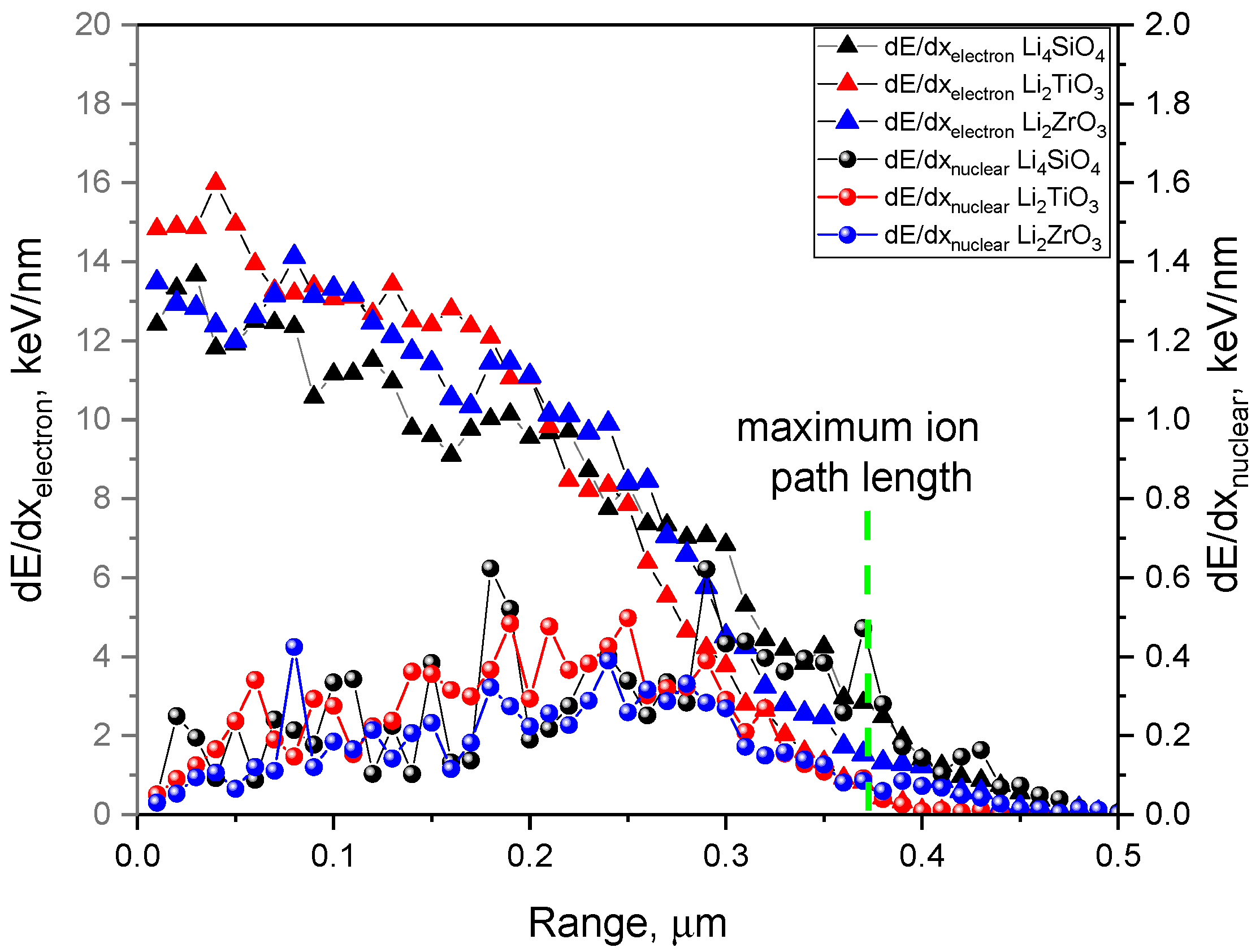

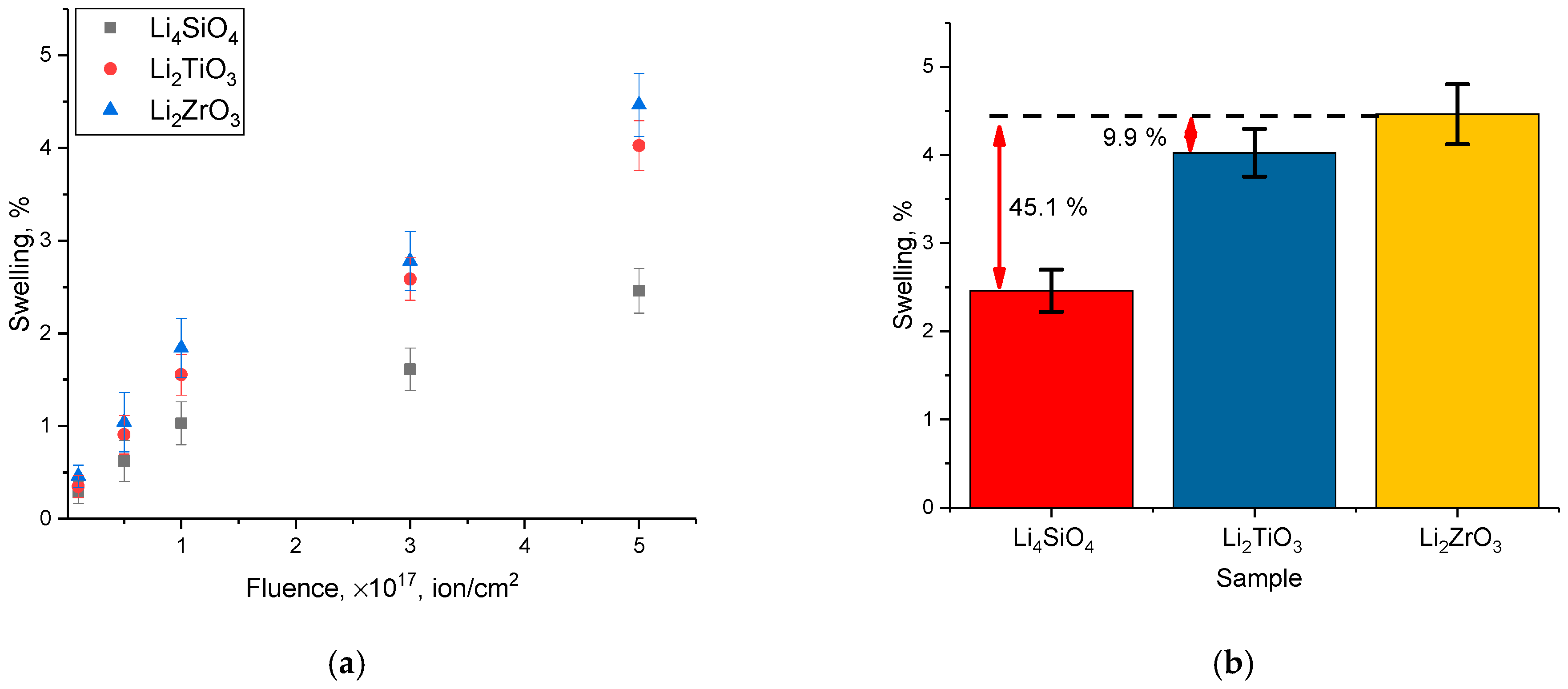
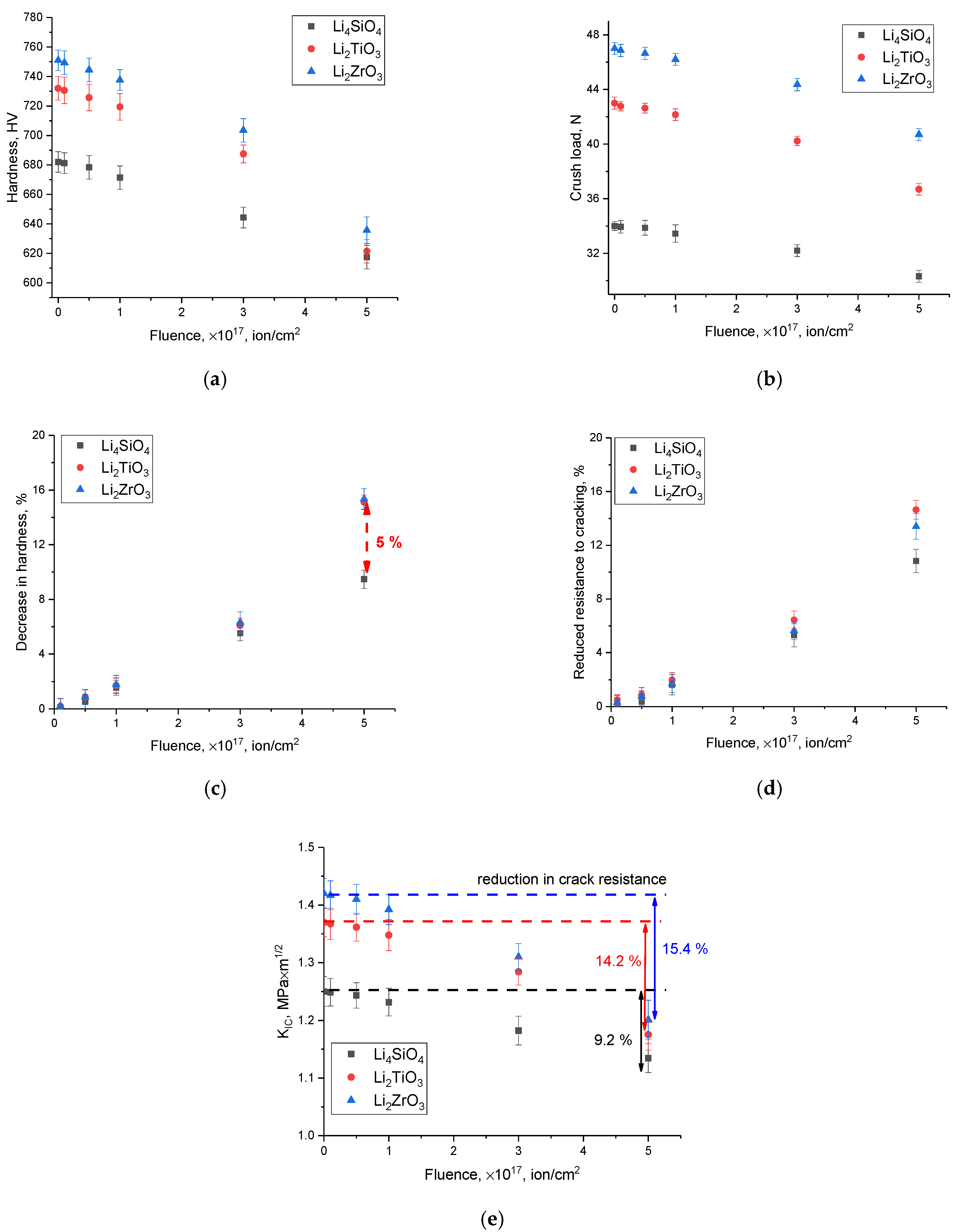
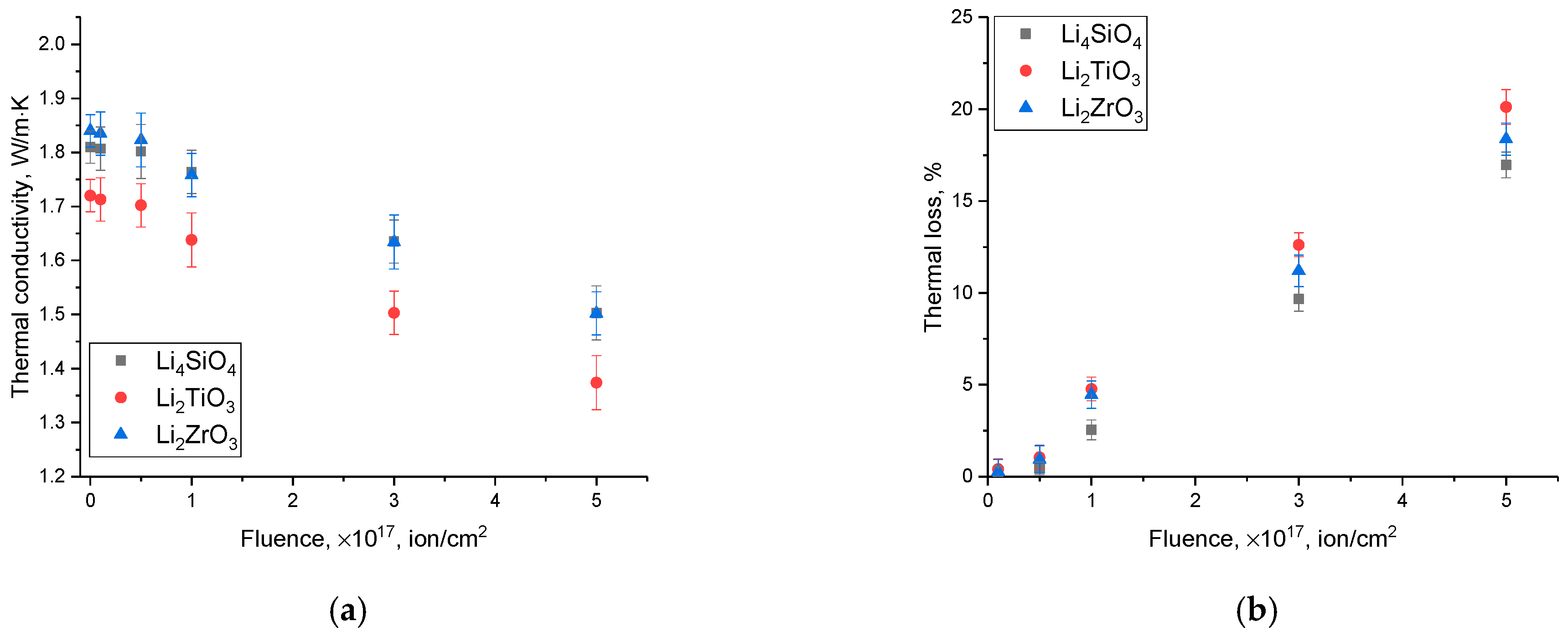
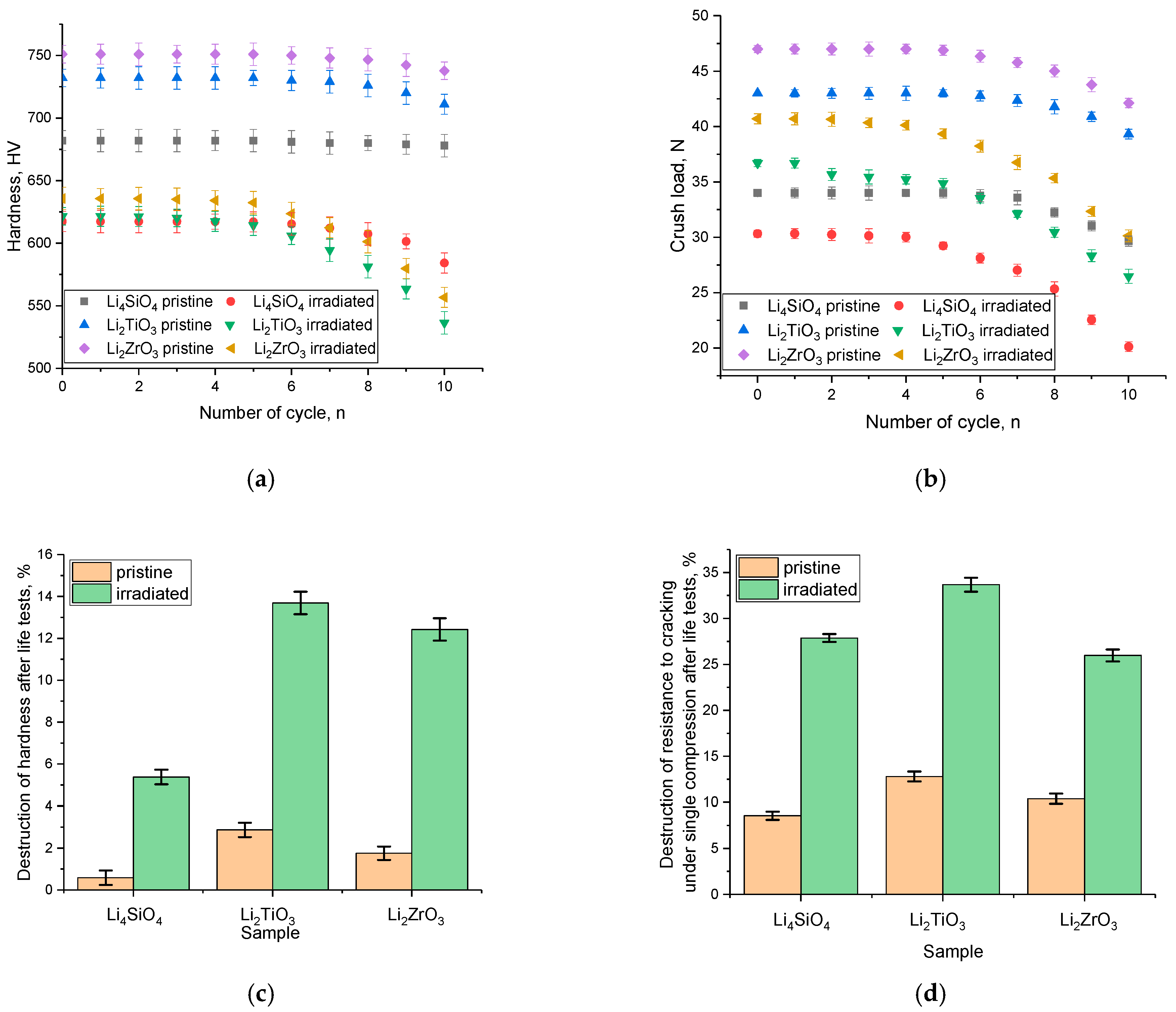
| Fluence, ion/cm2 | Li4SiO4 | Li2TiO3 | Li2ZrO3 |
|---|---|---|---|
| Lattice Parameter, Å | |||
| Pristine | a = 11.54015 ± 0.00042; b = 6.07448 ± 0.00053; c = 16.60257 ± 0.00024; β = 99.285°; V = 1147.60 Å3 | a = 5.05409 ± 0.00018; b = 8.76622 ± 0.00014; c = 9.73412 ± 0.00032; β = 100.141°; V = 424.54 Å3 | a = 5.39574 ± 0.00017; b = 8.98502 ± 0.00018; c = 5.38123 ± 0.00031; β = 113.132°; V = 239.91 Å3 |
| 1 × 1016 ion/cm2 | a = 11.53937 ± 0.00027; b = 6.08174 ± 0.00042; c = 16.62249 ± 0.00035; β = 99.405°; V = 1150.88 Å3 | a = 5.05813 ± 0.00036; b = 8.78022 ± 0.00034; c = 9.74968 ± 0.00035; β = 100.301°; V = 426.02 Å3 | a = 5.40219 ± 0.00025; b = 9.00656 ± 0.00028; c = 5.39198 ± 0.00021; β = 113.268°; V = 242.01 Å3 |
| 5 × 1016 ion/cm2 | a = 11.54859 ± 0.00025; b = 6.09146 ± 0.00036; c = 16.64241 ± 0.00025; β = 99.485°; V = 1154.75 Å3 | a = 5.07102 ± 0.00024; b = 8.79571 ± 0.00036; c = 9.76689 ± 0.00031; β = 100.462°; V = 428.30 Å3 | a = 5.40867 ± 0.00027; b = 9.02816 ± 0.00028; c = 5.41133 ± 0.00021; β = 113.449°; V = 242.41 Å3 |
| 1 × 1017 ion/cm2 | a = 11.55320 ± 0.00025; b = 6.09875 ± 0.00023; c = 16.68899 ± 0.00022; β = 99.603°; V = 1159.43 Å3 | a = 5.07910 ± 0.00024; b = 8.81677 ± 0.00024; c = 9.79419 ± 0.00016; β = 100.582°; V = 431.14 Å3 | a = 5.41947 ± 0.00024; b = 9.06787 ± 0.00028; c = 5.43509 ± 0.00032; β = 113.813°; V = 244.33 Å3 |
| 3 × 1017 ion/cm2 | a = 11.56706 ± 0.00027; b = 6.11090 ± 0.00023; c = 16.73568 ± 0.00022; β = 99.683°; V = 1166.11 Å3 | a = 5.08722 ± 0.00022; b = 8.84493 ± 0.00027; c = 9.85443 ± 0.00025; β = 100.824°; V = 435.52 Å3 | a = 5.43243 ± 0.00026; b = 9.10407 ± 0.00023; c = 5.46113 ± 0.00024; β = 114.085°; V = 246.58 Å3 |
| 5 × 1017 ion/cm2 | a = 11.58554 ± 0.00035; b = 6.12554 ± 0.00033; c = 16.61596 ± 0.00026; β = 99.844°; V = 1175.82 Å3 | a = 5.10143 ± 0.00026; b = 8.85192 ± 0.00024; c = 9.92141 ± 0.00018; β = 101.066°; V = 441.63 Å3 | a = 5.45196 ± 0.00026; b = 9.13319 ± 0.00023; c = 5.52893 ± 0.00025; β = 114.450°; V = 250.62 Å3 |
Disclaimer/Publisher’s Note: The statements, opinions and data contained in all publications are solely those of the individual author(s) and contributor(s) and not of MDPI and/or the editor(s). MDPI and/or the editor(s) disclaim responsibility for any injury to people or property resulting from any ideas, methods, instructions or products referred to in the content. |
© 2024 by the authors. Licensee MDPI, Basel, Switzerland. This article is an open access article distributed under the terms and conditions of the Creative Commons Attribution (CC BY) license (https://creativecommons.org/licenses/by/4.0/).
Share and Cite
Kozlovskiy, A.L.; Shlimas, D.I.; Borgekov, D.B.; Zdorovets, M.V. Study of the Resistance of Lithium-Containing Ceramics to Helium Swelling. Ceramics 2024, 7, 39-54. https://doi.org/10.3390/ceramics7010004
Kozlovskiy AL, Shlimas DI, Borgekov DB, Zdorovets MV. Study of the Resistance of Lithium-Containing Ceramics to Helium Swelling. Ceramics. 2024; 7(1):39-54. https://doi.org/10.3390/ceramics7010004
Chicago/Turabian StyleKozlovskiy, Artem L., Dmitriy I. Shlimas, Daryn B. Borgekov, and Maxim V. Zdorovets. 2024. "Study of the Resistance of Lithium-Containing Ceramics to Helium Swelling" Ceramics 7, no. 1: 39-54. https://doi.org/10.3390/ceramics7010004
APA StyleKozlovskiy, A. L., Shlimas, D. I., Borgekov, D. B., & Zdorovets, M. V. (2024). Study of the Resistance of Lithium-Containing Ceramics to Helium Swelling. Ceramics, 7(1), 39-54. https://doi.org/10.3390/ceramics7010004







